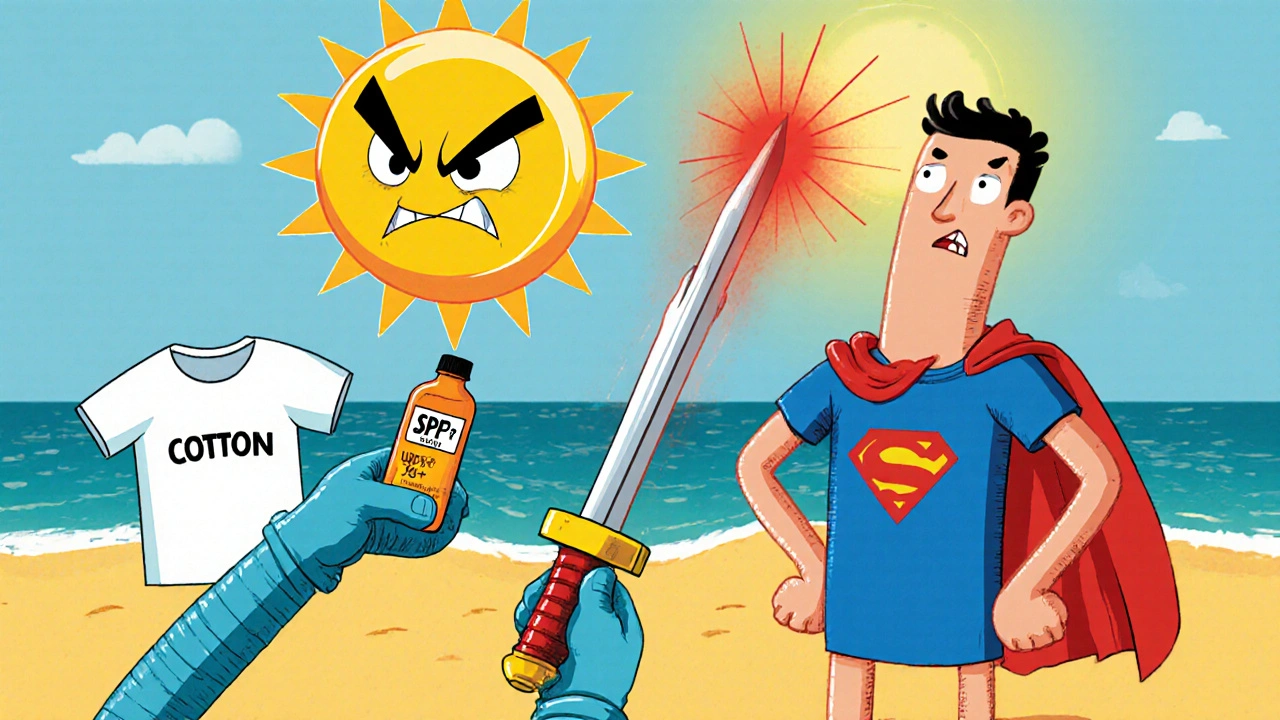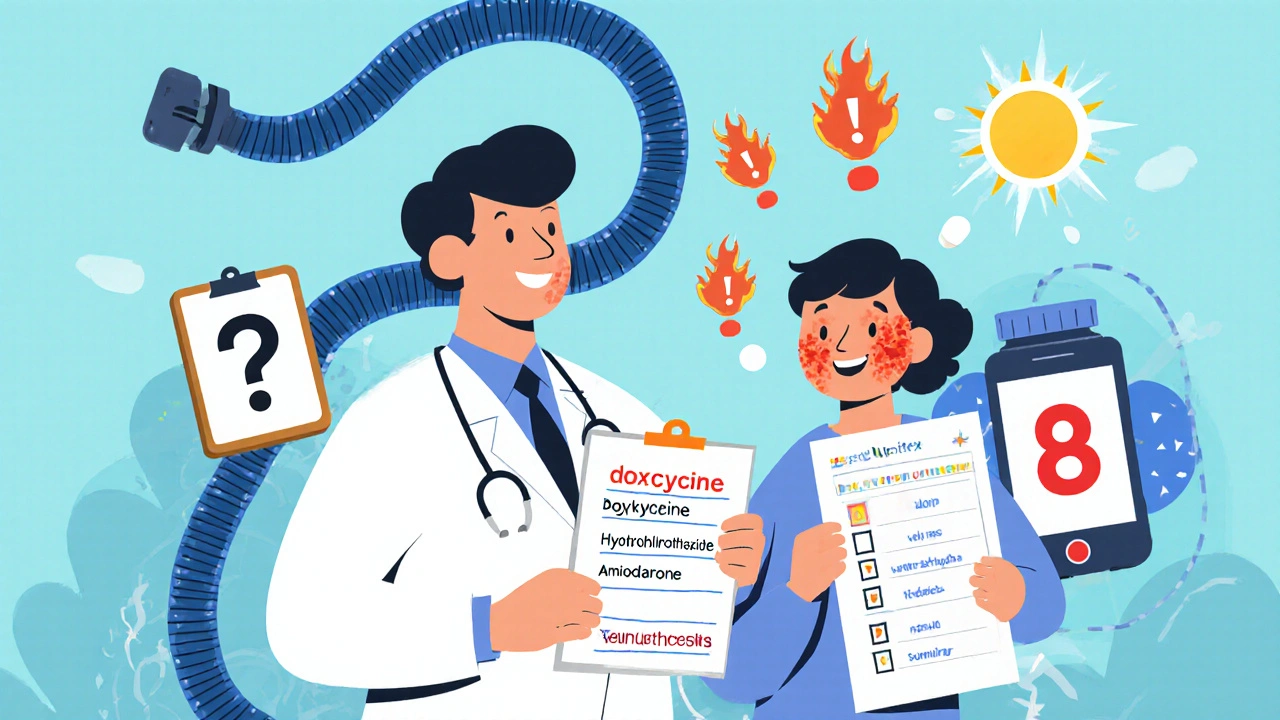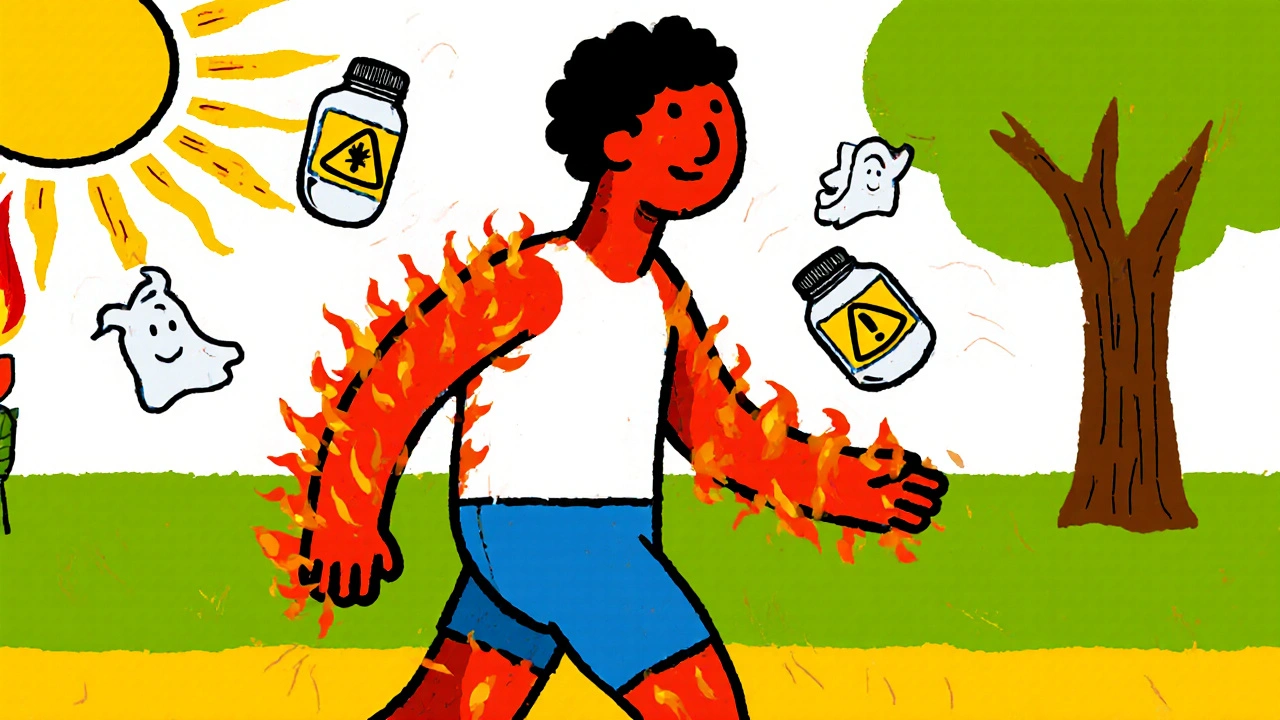Medication Photosensitivity Risk Checker
How Risky Is Your Medication Combination?
This tool helps you understand your risk of medication-induced photosensitivity based on your current medications and sun exposure habits.
What Is Medication-Induced Photosensitivity?
You take your pill like clockwork. You go for a walk, run errands, or sit outside for lunch-and within hours, your skin turns bright red, burns, or blisters. It feels like a bad sunburn, but you didn’t spend all day in the sun. This isn’t bad luck. It’s medication photosensitivity.
More than 1,000 common medications can make your skin dangerously sensitive to sunlight. This isn’t rare. About 1 in 5 people on certain drugs will react. And most don’t know it until it happens. The reaction isn’t just uncomfortable-it can lead to long-term skin damage and raise your risk of skin cancer by up to 60%.
There are two types: phototoxic and photoallergic. Phototoxic reactions make up 95% of cases. They happen fast-within minutes to a few hours after sun exposure. Think of it like your skin being set on fire by UV rays, with the drug acting as the fuel. Photoallergic reactions are rarer, slower, and trickier. They show up 1 to 3 days later, look like an itchy rash, and can spread even to areas covered by clothing.
Which Medications Cause Photosensitivity?
It’s not just sunscreen or tanning pills. The big offenders are everyday prescriptions you might never suspect.
- Tetracycline antibiotics like doxycycline: 10-20% of users get reactions. Used for acne, Lyme disease, and infections.
- NSAIDs like ketoprofen and ibuprofen: Especially common with topical gels. A single application followed by sun exposure can trigger a burn.
- Fluoroquinolones like ciprofloxacin: Prescribed for urinary tract infections and sinusitis. Even a short course can leave skin vulnerable.
- Amiodarone (Cordarone): Used for heart rhythm issues. Up to 75% of long-term users develop lasting photosensitivity-even years after stopping the drug.
- Sulfonamides: Antibiotics like Bactrim. Often cause photoallergic rashes.
- Diuretics like hydrochlorothiazide: Commonly prescribed for high blood pressure. One of the top causes in older adults.
- Retinoids: Acne treatments like isotretinoin and topical tretinoin. Make skin thinner and more vulnerable.
Women are twice as likely to get photoallergic reactions, mostly because they use more topical medications, cosmetics, and sunscreens with ingredients like oxybenzone that can themselves trigger reactions.
Why Standard Sunscreen Often Fails
You put on SPF 30. You think you’re protected. But if you’re on a photosensitizing drug, that’s not enough.
Most sunscreens focus on UVB-the rays that cause sunburn. But phototoxic reactions are driven by UVA, which penetrates deeper and passes through glass and clouds. The FDA says only 35% of SPF 50+ sunscreens offer real UVA protection. That’s why people on doxycycline still burn through clothing on a cloudy day.
Look for sunscreens with zinc oxide or titanium dioxide as the main active ingredients. These minerals sit on top of the skin and physically block both UVA and UVB. Avoid chemical filters like oxybenzone, octinoxate, and avobenzone if you’re prone to reactions-they can irritate skin or even cause photoallergy themselves.
Apply at least one ounce (a shot glass full) for your whole body. Most people use only 25-50% of what’s needed. Reapply every 2 hours, even if you’re not sweating or swimming. And don’t forget ears, neck, hands, and feet.

Physical Barriers Work Better Than Sunscreen
If you’ve ever worn a hat and felt like you were still getting burned, you’re not imagining it. Regular cotton T-shirts block only 3-20% of UV rays. A white T-shirt worn wet? That drops to 5%.
UPF 50+ clothing blocks 98% of UV radiation. Brands like Solbari, Coolibar, and UV Skinz are designed for people with photosensitivity. They’re lightweight, breathable, and tested to maintain protection after washing. One user on MyHealthTeams reported a 90% drop in flare-ups after switching to UPF 50+ shirts and wide-brimmed hats.
Wear long sleeves, even in summer. Sunglasses with UV protection. Wide-brimmed hats (not baseball caps). These aren’t optional-they’re medical necessities if you’re on a photosensitizing drug.
When and How to Avoid the Sun
It’s not just about avoiding the beach. UV radiation peaks between 10 a.m. and 4 p.m. But even early morning or late afternoon sun can trigger reactions if you’re on certain medications.
Use a UV index app like UVLens. When the index hits 3 or higher, treat it like a red flag. Limit time outside. Seek shade. Reschedule walks, gardening, or errands for early morning or evening.
Indoor lighting? Most fluorescent and LED lights are safe. But halogen and incandescent bulbs can emit small amounts of UVA. If you’re on amiodarone or other high-risk drugs, avoid sitting right next to bright desk lamps or reading lights for long periods.
Why Doctors Often Miss This
Here’s the uncomfortable truth: up to 70% of photosensitivity cases are misdiagnosed. Patients are told they have “sun allergy” or “polymorphic light eruption.” But it’s not an allergy-it’s a drug reaction.
Most primary care providers don’t screen for photosensitivity when prescribing high-risk meds. A 2022 survey found that 68% of patients received no sun safety advice when they were given doxycycline, hydrochlorothiazide, or other dangerous drugs.
That’s changing slowly. Dermatologists now routinely ask about medications when someone presents with unexplained rashes. But if you’re seeing a general practitioner, you need to speak up. Say: “I’m on [medication name]. Is it known to cause sun sensitivity?”

What to Do If You React
If your skin turns red, swells, or blisters after sun exposure:
- Get out of the sun immediately.
- Cool the area with a damp towel or cool bath. Avoid ice.
- Use over-the-counter hydrocortisone cream (1%) for itching and inflammation.
- Take ibuprofen for pain and swelling-unless you’re already on NSAIDs, which could be the cause.
- Stay hydrated.
- Call your doctor. Don’t wait for it to get worse.
Don’t pop blisters. Don’t scrub the skin. Don’t keep exposing it to the sun. This isn’t a minor burn. It’s a sign your skin is under chemical attack.
What’s New in 2025
There’s real progress. The FDA approved a new oral photoprotective drug called Lumitrex in 2023. It reduces UV-induced skin damage by 70% in trials and is now being tested for use with high-risk medications like amiodarone.
Companies are developing “smart” sunscreens that change color when UV exposure gets dangerous. 23andMe now offers a genetic test that identifies variants linked to higher photosensitivity risk-useful if you’ve had unexplained reactions before.
More pharmacies are adding automatic alerts in their systems. If you’re prescribed doxycycline or hydrochlorothiazide, you might get a printed warning card at pickup. But don’t count on it. You still need to ask.
Final Checklist: Your Sun Safety Plan
If you’re taking any medication, use this checklist:
- ☐ Check if your drug is on the FDA’s list of photosensitizers (search “FDA photosensitivity medication list”)
- ☐ Ask your doctor or pharmacist: “Does this cause sun sensitivity?”
- ☐ Use zinc oxide or titanium dioxide sunscreen, SPF 50+, reapplied every 2 hours
- ☐ Wear UPF 50+ clothing, wide-brimmed hat, and UV-blocking sunglasses daily
- ☐ Avoid sun between 10 a.m. and 4 p.m. when UV index is 3 or higher
- ☐ Use a UV index app to plan outdoor time
- ☐ Keep a symptom diary: note medications, sun exposure, and skin reactions
- ☐ Tell your dermatologist about any unexplained rashes or burns
Medication photosensitivity isn’t something you just live with. It’s preventable. With the right tools and knowledge, you can enjoy the sun without risking your skin.


Post A Comment